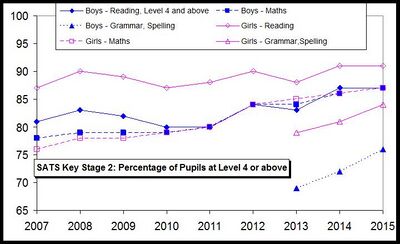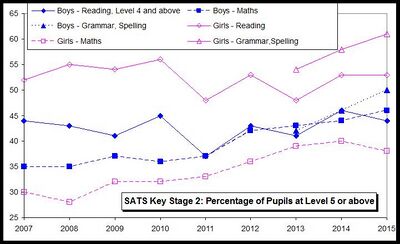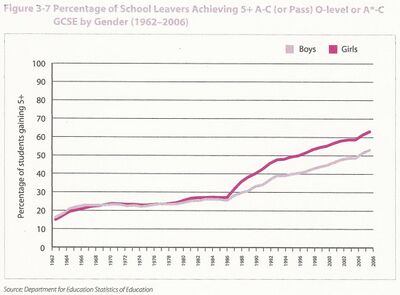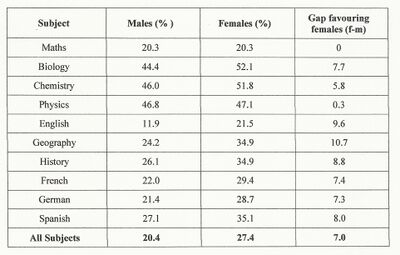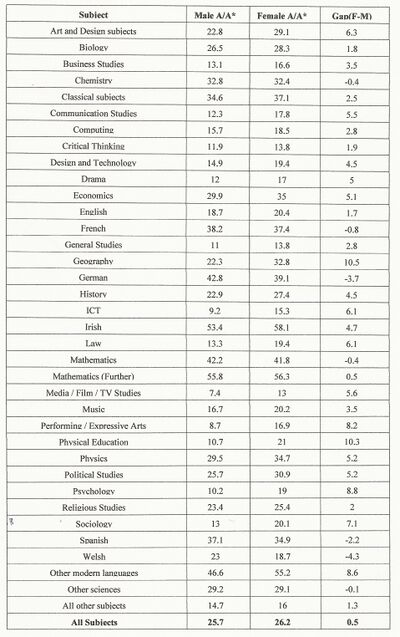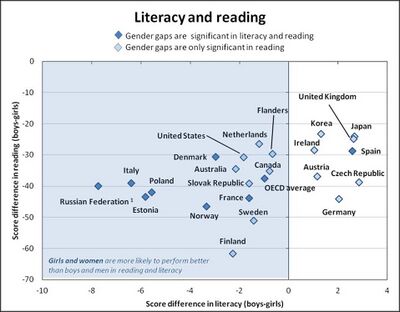| MediaWiki[wp] is hostile to Men, see T323956. |
| For the first time in 80 years, German tanks will roll against Russia.
Germany has been a party to the war since 1404 days by supplying weapons of war. German Foreign Minster Annalena Baerbock: "We are fighting a war against Russia" (January 25, 2023) |
Boys Failing in Schools
Boys Failing in Schools is a sub-topic within Part 1 of the Self-Study Guide on the MHRM in the UK. Presented here are comparative data on the performance of the genders in primary and secondary school education. It is evident that boys are under-performing relative to girls and evidence is presented, or referenced, relating to the bias of teachers and/or pedagogy which might underlie this male under-performance.
Primary Schooling
Boys are trailing girls in reading and writing, though comparable or better in maths, as measured by SATS Key Stage 2. The governmental data shows,[1]
There is evidence that teacher assessments at SATS KS2 level show bias in favour of girls. However, there is little doubt that at this stage boys genuinely lag girls significantly in reading and writing. The concern is that this disadvantage in literacy causes an ongoing disadvantage throughout secondary schooling. Whilst there might be an innate difference between the sexes in literacy, at least at this age, there is also evidence that the prevailing attainment gap is exacerbated, if not caused entirely, by school regimes which favour girls' temperament and behaviour over that of boys. Academic evidence from the USA in support of this contention includes C.M.Cornwell, D.B.Mustard and J.Van Parys, "Non-Cognitive Skills and the Gender Disparities in Test Scores and Teacher Assessments: Evidence from Primary School", IZA Discussion Paper No. 5973, September 2011.
In the UK, a graphic illustration of the reality of this perspective was provided by Gareth Malone's 2010 experiment.[2] In this series of three one-hour programmes on BBC TV, Gareth Malone[wp] accepted the challenge of improving the reading ability of the 10 year old boys at a fairly typical primary school - where many boys were two years behind the girls in reading age. Despite not being a teacher himself (though a brilliant motivator), Malone succeeded in meeting the stiff targets set by the Head Teacher. He did so by adopting a boy-centred approach and teaching the boys separately from the girls. Despite having so emphatically demonstrated how boys' primary education may be improved, our society has failed to emulate this good example.
Boys as young as 7 already expect to do less well at school than girls, so say Bonnie Hartley and Robbie Sutton (Child Development, Volume 84, Issue 5, pages 1716–1733). At this tender age, girls think that girls are cleverer than boys - and boys agree with them. Moreover, this attitude appears to emanate, not just from schools, but from society more generally. Boys feel they are not expected by their parents or their teachers to do as well as girls. They loose their motivation and confidence as a result. Low expectations breed low achievement, a phenomenon which feminists are keen to emphasise when females are under-represented.
Bluntly put, "boys are not politically correct", says Christina Hoff Sommers[3] introducing her book The War Against Boys (2000). In this video, Hoff Sommers observes that boyish behaviour is being increasingly interpreted as pathological - in schools as elsewhere - and that this is a major cause of their educational failure. She warns against people who present themselves as saviours of boys if their approach is to demonise their boyish nature. Masculinity is not toxic but we are told that it is - and increasingly many teachers think so. It is hardly surprising that many boys do badly in a system which essentially just doesn't like them.
Secondary Schooling: Age 16
At age 16 years, boys again do substantially worse than girls. In the UK the conventional measure of educational attainment at this age is to achieve five or more GCSE Grades A* to C. The historical comparison between the sexes, from 1962 to 2006, using this measure (or the earlier GCE 'O Level' equivalent) is shown below (taken from the Department of Education & Skills' report, 2007).[4]
The much discussed poorer performance of boys at age 16 started rather abruptly in 1987/88 - a date which coincides with replacing GCE O Levels with GCSEs. This suggests the gender gap may be a result of the nature of the award rather than a true measure of difference in ability.
In addition, there is now ample evidence that secondary school teachers, like primary school teachers, mark boys down compared to girls, as summarised here. This is particularly concerning for awards like GCSEs, and A levels, which include a substantial course-work element which is marked by the teachers.
More recent data modifies the accepted GCSE standard to include the requirement that the 5 Grades A*-C must include English and Maths, and so is not directly comparable to the earlier data. However, a gender gap of ~10% remained in 2012/13, (65.7% of girls and 55.6% of boys in England reaching the standard). In 2015 the gender gap may have reduced slightly to 8.4%.
However, figures for the genders as a whole disguise the strong socioeconomic dependence of educational attainment. Being poor, white and male is the worst combination. Even the EHRC's "Is Britain Fairer" report (2015), hardly a model of concern for males, notes that, "The socioeconomic attainment gap was greatest for White boys. In England and Wales, by broad ethnic group, White FSM boys continued to have the lowest educational attainment in their respective countries at age 16 in 2013. In 2012/13, just 28.3% of White FSM boys achieved the GCSE threshold in England, compared with 59.1% of White non-FSM boys. For White FSM and non-FSM girls, the rates were 37.1% and 69.5% respectively". (FSM = free school meals, an indicator of economic disadvantage).
Perhaps a better measure of attainment than "five passes at Grades A*-C" is achieving the top A/A* Grades. 2012 data show that a larger percentage of girls than boys achieve A/A* Grades in every major subject (except maths, where they are equal). The gender gaps, defined as the female - male difference between the percentages gaining the top grades, are as shown opposite.
The gender gap apparent at GCSE may be the major reason for the subsequent gender gaps at A-level and hence also at university entrance. For example, the 2009 Higher Education Policy Institute report, "Male and Female Participation and Progression in Higher Education", concluded that, "The difference in achievement at GCSE has been shown to be sufficient to explain the differences in higher education participation. What is more, there are strong indications that the nature of the GCSE assessment (and the nature of the teaching and curriculum that feed it) is part of the reason for the relatively poor performance of boys". [The 2009 report is no longer available on the live internet, but a 2010 supplement is].
Secondary Schooling: Age 18
The reporting of A Level results in the press recently has been very misleading. In 2014 virtually all newspapers had headlines like The Telegraph's, "A-levels 2014: gender gap between boys and girls closing". The basis of this claim was the fact that, over all subjects, females had only a 0.5% lead over males in attaining top A/A* grades. But this is a difference between the percentages gaining top grades for each sex. It says nothing about the absolute numbers. On this spurious measure, if just two males took A Levels and both got a top grade, and one million females took A levels with half a million gaining top grades, the males would be doing better! This manner of reporting is another way of disguising the underlying male disadvantage.
In fact, the 2014 data shows that 74,161 more females took A Levels (379,823 males versus 453,984 females), an excess of females over males of 20%. Over all subjects, the excess of females gaining grades A*, A or B was 11%, 27% and 36% respectively. You see how misleading that claim of a "0.5% lead" was?
Perhaps more alarmingly, the percentage of female candidates gaining a top A/A* grade exceeds that for males in 30 out of the 37 subject areas listed, as shown opposite.
Again there are indications that A Level awards may favour females, for example compared to standard attainment tests. As with Key Stage 2 SATs, there is also evidence that teachers favour girls over boys, marking girls higher than boys given what would be expected based on test scores. Remarkably the very studies which show this will nevertheless emphasise issues such as the smaller number of girls taking STEM subjects, or the (claimed) lack of confidence of girls, whilst down-playing the issue of teacher bias, e.g., in the web page introducing the 2012 PISA report. See here for what this report actually reveals.
Adult Literacy
The poorer performance of boys in literacy persists from primary through secondary education, and this fact may be implicated in boys' poorer performance in other subjects (because verbal articulacy is important in most subjects). It is of interest, then, to find that the apparent male weakness in literacy has disappeared by the time they are in their twenties, as shown by the results of the Programme for the International Assessment of Adults' Competencies (PIAAC), shown plotted below in comparison with tests 15 year olds (Programme for International Student Assessment, PISA). This again suggests that boys' underperformance in literacy at school may be due more to the schools, or perhaps to society, than to the boys.
X-axis: PIAAC Literacy Proficiency Gap for Adults, versus, Y-axis: PISA Reading Proficiency Gap at Age 15 (Positive Means Boys Are Stronger). Illustrates that male under-performance in literacy at school does not persist into adulthood in the UK.
References
- ↑ National Statistics: National curriculum assessments at key stage 2: 2015 (revised), gov.uk
- ↑
 Gareth Malone's Extraordinary School for Boys - Episode 1 of 3 (Error: Invalid time.) (Size: 58:43 min.)
Gareth Malone's Extraordinary School for Boys - Episode 1 of 3 (Error: Invalid time.) (Size: 58:43 min.)
- ↑
 Christina Hoff Sommers: "The War Against Boys" (Book TV, 14/7/01) (July 20, 2015) (Size: 45.45 min.)
Christina Hoff Sommers: "The War Against Boys" (Book TV, 14/7/01) (July 20, 2015) (Size: 45.45 min.)
- ↑
 Gender and Education: the Evidence on Pupils in England[ext], 2007 (128 pages)
Gender and Education: the Evidence on Pupils in England[ext], 2007 (128 pages)
